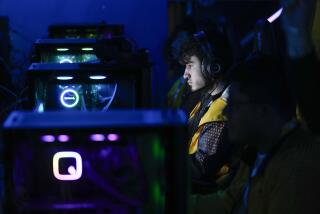After ‘bro culture’ crisis, ‘League of Legends’ esports ruler Riot touts new game, new outlook
For much of 2020, the developers at the Santa Monica-based studio Riot Games have been prepping for the release of “Valorant,” a highly competitive video game that seems predestined to become the next esport sensation. After all, over the past decade, Riot’s “League of Legends” has been the most popular esport in the world — its tournaments can draw audiences that dwarf those of the Super Bowl.
And so in the days leading to Tuesday’s launch, the makers of “Valorant,” Riot’s first tactical shooter game, experienced the avalanche of emotions that come with unleashing a game on the public.
There has been pride: “Valorant” runs on a complex back-end designed over a six-plus-year development cycle to heighten the choreography of virtual team play.
There’s been anticipation: Riot has invested big in “Valorant” — “hundreds of millions of dollars,” says CEO Nicolo Laurent — with the hope of launching not only a new game but also a new era for Riot, one that sees the studio diversifying its game roster and fostering a new online community.
And there’s also been caution: “Valorant” developers recognize that some will use its game tools for abuse, whether it’s egregious verbal harassment or finding ways to cheat.
And that says nothing of launching a communal game during steadily intensifying protests against systemic racism and police brutality, as well as a global pandemic.
Riot CEO Laurent posted a note with Tuesday’s launch of “Valorant” acknowledging that “the days are tense and draining,” but he also expressed the hope that “Valorant” could be “a small bright spot ... during an otherwise dark time.” The studio also said it was refocusing its charity efforts to direct funds to criminal justice reform and “local communities with a focus on black-owned businesses,” and would match up to $1,000 per Riot employee donation, with details, according to a spokesperson, to be issued in the coming days.
“I think at Riot we’re pretty idealistic, which is good and bad,” says co-founder Marc Merrill.
Good in that the company believes in the power of interactive entertainment as a force of positivity. Indeed, Merrill envisions a future in which Riot’s games have a starring role in a Little League-like youth organization designed not only to spur interest in esports but also to teach kids teamwork and cooperation. Bad in that dealing with a player base of 100 million can, when just a fraction of that audience is angry, “manifest in a pretty negative feeling,” Merrill says, “when someone can directly tweet at you.”
So when Riot’s leaders talk about being “on the front lines,” it’s an acknowledgement of the inherent challenges of running an always-on and aggressively cutthroat game with a passionate online community not always known for civility — and who sometimes, unnervingly, have gotten hold of staffers’ personal email addresses and phone numbers. Whereas the Dodgers can largely tune out its audience’s jeers and cheers when fans leave Chavez Ravine, it’s tougher for Riot. Its virtual arenas are in players’ homes around the globe, where amateur and pro players and spectators intermingle. Monitoring all the cheers and gripes of its internet-savvy players comes with the territory, company leaders say.
Anna Donlon, the developer leading “Valorant,” says, delicately, that “the special ways information can be presented” from fans can be challenging. That’s something she’s learned from years working in the shooter space. But Riot is prepared to listen.
“It’s built into our DNA, being very involved in players,” says Donlon, who joined Riot in 2015 after working on multiple “Call of Duty” titles. “We did not realize the shooter community has been hungry for this engagement from its developers. We’ve been hearing a lot about it since our closed beta. ‘I hope you don’t go away. I hope you’re still out there.’ And yeah, we commit to being out there — with armor on.”
“Arcana,” a new game with an old Los Angeles murder at its center, is reviving the ARG (alternate-reality game) format by utilizing Instagram.
With the Riot name and the studio’s ability to tweak familiar genres into something that feels like a fresh competitive landscape, it’s considered a foregone conclusion that “Valorant” will be huge. When Riot made the game available to popular streamers for beta testing in early April, “Valorant” drew an audience of more than 1.7 million people.
“It is not an unknown quantity we’re dealing with with Riot,” says John Robinson, president and chief operating officer of L.A.’s 100 Thieves, home to numerous esports teams and a related apparel brand. “They know how to build a community. They know how to foster a competitive community. We have a lot of faith they’re going to do right by the people who are really into this game. It’s just a question of how strongly the community reacts and how quickly it grows.”
With more games in development and the possibility of an animated TV series set in the “League of Legends” universe, the hope is that Riot, solely associated with “League of Legends” for the past decade, will be recognized as a name outside the world of esports.
“To try to train and align and build an organization that can iterate on all different types of media, from games to sports to music and other aspects of entertainment, is a really hard problem to solve,” says Merrill.”We’ve been hunkered down, trying to build an organization that’s capable of doing all of these things.”
In getting to this pivot point, some of Riot’s toughest battles have been internal ones. The studio, says Merrill, who started Riot with former roommate Brandon Beck, is still in the midst of an ongoing “existential threat,” a personal-growth journey that is “never-ending.”
In August of 2018, Riot was the subject of an extensive article in Kotaku that detailed a toxic “bro culture” at the company and compared working there to being employed by a fraternity where “women are treated unfairly, where the company’s culture puts female employees at a disadvantage.” In November of that year, a class-action lawsuit was filed after two women alleged they had been routinely subjected to sexual harassment and gender discrimination.
At the time, the California Department of Fair Employment and Housing questioned a $10-million settlement offer by Riot and said the women could be owed millions more in potential back pay. The case is ongoing.
“To realize that, for a whole population of people at Riot, that we essentially failed them was just a horrible realization,” says Merrill. “That was obviously an important moment for soul-searching, not only for us but the entire company. I think we don’t know any other way to be except for being a company that takes a hard look at ourselves and has a conversation. Let’s understand what we’re doing well and not doing well and how we can get better and acknowledge things we weren’t aware of.”
Riot, founded in 2006 in West Hollywood and now owned by Chinese gaming giant Tencent, has 23 offices around the world and about 3,000 staffers. The studio had to reckon with its workplace culture at a particularly fragile time, with Riot ramping up on “Valorant” and other new products.
Donlon, who at that point had only been at Riot a couple of years, said the stories that started to come to the fore shook her.
“I wouldn’t want to say I represent how all Rioters might feel, but the types of things that were being discussed I’ve experienced my whole career,” says Donlon. “I’m almost 25 years into my career in this industry, and what felt disappointing to me was that this could exist here as well. I felt that maybe Riot was the place that wasn’t vulnerable to these type of things. Disappointed is such a harsh word. When I tell my kids I’m disappointed in them, they’re in agony for a week, but that’s how I felt. ‘Oh no, not here, too.’”
Games are a playground, a place to see what happens when we do what we aren’t told, and a world in which failure is embraced — welcomed, even — as a way to learn. Why play matters in times of stress.
Although far from the only company to reevaluate its workplace in recent years, Riot has been one that has been relatively outspoken in how it’s trying to address its internal issues. Last year the company hired Angela Roseboro as its first-ever chief diversity officer, reporting to chief people officer Emily Winkle, another recent hire focused specifically on Riot’s staff and growth opportunities.
Although executives interviewed for this story are careful to say nothing is solved, Riot has diversified is leadership roles, noting in a recent report that it is currently 28% female and 45% minority-led. It has conducted pay-equity studies and created a number of employee resource groups to foster communications and connections, among other initiatives. Longtime employees note that the Kotaku article led to a period of intense reflection, including a closer look at work-life balance and what it means to be professional in the video game industry, where work can feel like an extension of personal hobbies and private life.
“When I reflect on my behavior as a gamer 10 years ago, the things I would say to people in games? I have regrets,” says Riot’s Jeff Jew, executive producer of the mobile-focused digital card game “Legends of Runeterra.” And yet Jew is hopeful that “the social conduct in games is improving at a rapid pace. We have Anna Donlon leading ‘Valorant,’ and the hardcore shooter space is one of the scariest places you can go. It’s extremely competitive. It’s male dominated, mostly. It’s very hardcore. Riot, we’re going to try and help how people treat each other in those games. Honestly, because of what we went through, we’re better equipped to handle these conversations.”
Challenging moments, if handled right, can also be a time of bonding.
“They were able to build my trust,” says Donlon of the response from Riot’s top executives. “Even if they didn’t have the right solutions quickly, they were going to keep working at it. That allowed me to not worry about it as much and focus on the work, and I don’t think we could have shipped these games we’re shipping if the highest levels of the company did not say, ‘This is on us.’”
Donlon wasn’t hired to lead “Valorant” but raised her hand as soon as she found out about the project. “Valorant” represents a departure for Riot on multiple fronts. In addition to the emphasis on gunplay, it takes the company out of the fantasy-based world of “League of Legends.” Although the characters have some magic abilities in “Valorant,” those are designed to be used in a more strategic manner, constructing obstacles or defenses that lead an opposing team into a bullet.
Thus, the look is grounded but slightly mystical. The architecture is broken and sometimes floating as, over time, Riot intends to build in a backstory for the game. And though inspiration may come from a place such as Italy, says Donlon, the game isn’t reflecting “real-world Italy,” but that’s largely due to Riot’s desire to create an art style that can perform on a broad range of personal computers.
“The map that we launch with is floating in air,” says Donlon. “Something is happening to shift the world, but we also didn’t want to lean too hard into magic. We don’t want it to feel like sorcerers and wizards. This is a real-world game with real-world stakes. It’s highly lethal. You do not stay alive long in this game, so we don’t want it to feel too fantastical.”
Donlon also knows that a game like “Valorant” can be intimidating, especially to solo or female players. Though designed to be played specifically with a team that can adapt to one another’s styles of play, which often requires constant voice communication, Donlon notes the studio is investing in non-voice options — as a method for cutting down on in-game harassment — that will continue to be honed over time. She went so far as to release a pre-launch statement saying it would be “irresponsible” to accept such harassment as status quo.
That will continue to evolve, especially if “Valorant” is as competitive as Riot hopes, which could lead to some highly emotional, borderline volatile matches. “It’s for the shooter player who really wants to compete, wants to master this game, wants to get better,” she says. “I think that’s why it feels like a natural fit for an esport at some point. This is made for the player who wants to spend years and years getting better.”
And yet Riot’s focus shouldn’t be considered a narrow one, at least not anymore. Although “Valorant” is the studio’s first major step beyond “League of Legends,” it is on a mission to further diversify its content beyond high-stakes player-versus-player battles.
“Arcane,” an animated series that is set in the “League of Legends” world is in the works, as are other games that put a greater emphasis on story or role-playing game elements.
So while Merrill hopes for a future in which parents drive around with bumper stickers touting their teen’s participation in esports, Laurent says he’s thinking bigger. Although Riot’s roots are in competitive games, he says the company will continue to grow. Think of Riot, he says, like the first or second decade of the Walt Disney Co., when the company was still primarily known for animation.
Those who pay attention to Riot’s esports competitions know the company has created virtual bands, and Laurent hints that such entertainment experimentations have broader goals than to just advertise “League of Legends.” He cites his daughter’s love of “Frozen” or his friends who champion “Star Wars” and notes he isn’t a fan of either but can still get excited about seeing the “Frozen” musical or visiting the “Star Wars” lands in Disney’s parks due to the spectacle of it all.
Games, he says, will begin to transcend their appeal beyond their core audience. And he wants Riot to lead the charge.
“If you think about the 20th century, you’re thinking of Disney as the entertainment company of that century,” Laurent says. “But if you’re looking at the 21st century, the company of the 21st century will have its roots not in family entertainment but in gaming. That’s the biggest sector, the fastest-growing one and the most interesting one. Everybody is playing. So if you believe in that assumption, that the entertainment company of the 21st century has their roots in gaming, I think we’re pretty well positioned to take a crack at it.”
More to Read
The biggest entertainment stories
Get our big stories about Hollywood, film, television, music, arts, culture and more right in your inbox as soon as they publish.
You may occasionally receive promotional content from the Los Angeles Times.











